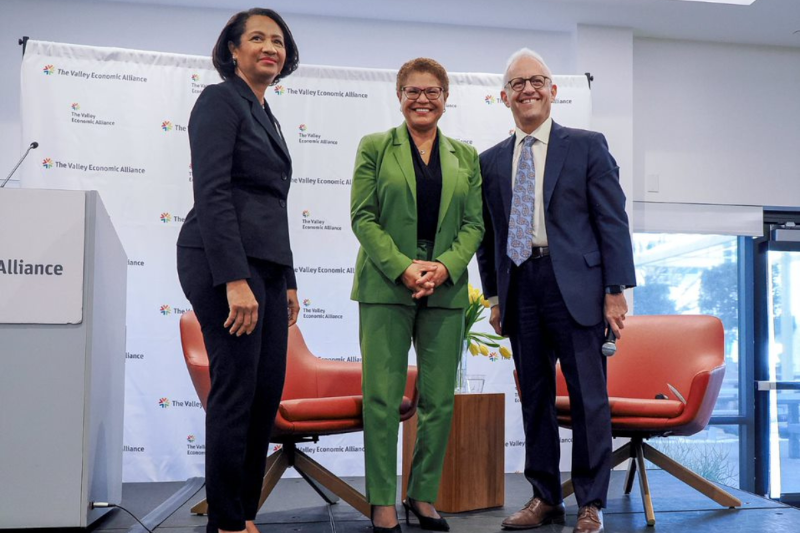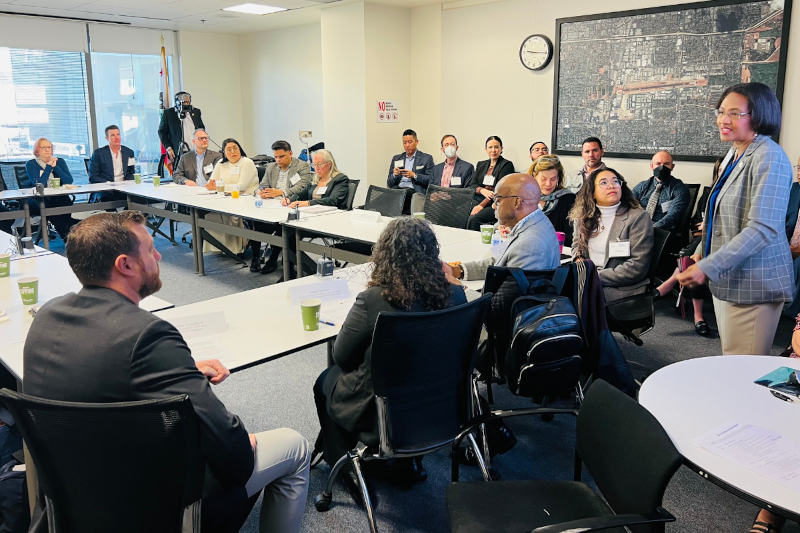Valley Economic Alliance
Supporting Growth and Innovation in the Heart of Los Angeles
Underpinning the future of the San Fernando Valley through strategic investments, community engagement, and innovative initiatives ahead of the 2028 Olympics and beyond.
The Valley Economic Alliance has a storied history that speaks to the power of resilience and community solidarity. Born in 1995, it emerged from the rubble of the 1994 Northridge earthquake, a natural disaster that shook the San Fernando Valley to its core. Sonya Blake, the Alliance’s President and CEO, describes its inception as “a story of the phoenix rising from the ashes.” She recalls the chaos and damage that followed the quake, occasioning the need for a centralized force to help rebuild and restore order.
In the wake of the earthquake, several local leaders recognized the necessity of a nonprofit entity that could equitably distribute FEMA emergency relief funds and convene stakeholders in the effort to reconstruct the community. Among these visionaries were the Valley Industry Commerce Association, the United Chambers of Commerce, and prominent individuals like David Fleming, David Honda, and Bob Scott.
“They got together and decided that there was a need for a nonprofit organization,” Blake recounts, “a collective resolve to create what would become the Valley Economic Alliance.” This group and others served on the board of directors, giving birth to a nonprofit that has been a linchpin in the Valley’s economic development ever since.
Four Pillars of Operational Excellence
Blake elaborates on the Alliance’s current operations, framing it as a comprehensive community and economic development organization with a wide purview. The Alliance’s efforts are divided into four key initiatives: Economic Development, Workforce Development, Livable and Sustainable Communities, and Diversity, Equity, and Inclusion.
Economic development is at the forefront of its mission. The Alliance provides a free business assistance program to support companies in starting up, recovering, and accessing resources. Blake emphasizes the importance of strategically deploying the region’s real estate, helping developers identify underinvested areas ripe for housing and job-creating businesses. “We also promote tourism,” she notes, showing the Alliance’s role in boosting local commerce by guiding visitors to the Valley’s restaurants, amenities, and entertainment venues.
The second initiative, Workforce Development, addresses the pressing need for skilled labor in a post-pandemic world. According to Blake, this initiative connects employers with qualified employees and helps job seekers find training opportunities to upskill. “It’s an area that’s really growing and burgeoning,” she says, pointing out the recent labor market disruptions that have made this work more crucial than ever.
Blake also speaks passionately about the Livable and Sustainable Communities initiative, which enhances the quality of life in the Valley. This encompasses promoting housing development, raising public awareness about environmental sustainability, and preserving parks and recreation spaces. The goal is to make the Valley an attractive place to live, work, and play. “It’s about really promoting the preservation of our parks and recreation,” she explains, emphasizing that quality of life is a key component in their overall strategy.
Rounding out these efforts is the Diversity, Equity, and Inclusion initiative, which Blake describes as integral to everything they do. The Valley is home to a diverse population, and the Alliance ensures its programs reflect and serve this diversity. “We want to make sure that our programs are serving people from a whole variety of our stakeholders,” Blake asserts, adding that this extends to its governance structure, ensuring diversity and inclusion at all levels.

A Unique Approach to Marketing and Communication
For an organization like the Valley Economic Alliance, marketing isn’t just about spreading the word; it’s about engaging deeply with the community and standing apart in a crowded field. Blake stresses that the Alliance’s marketing efforts begin with its “83-member board of directors,” a notably large and diverse group.
“It enables us to really represent the community that we serve,” she explains. With representatives from banking, major corporations, nonprofits, educational institutions, and social service providers, the board acts as advocates across various sectors. These advocates help advance the Alliance’s mission, spreading the word in their respective arenas and ensuring the Alliance’s presence is felt throughout the Valley.
Beyond the board’s advocacy, the Alliance has built a robust communication infrastructure. Blake points out that its extensive email list has been cultivated over nearly 30 years of service. “We’ve been able to serve quite a few organizations, over 46,000 Valley businesses,” she notes. This extensive reach facilitates word-of-mouth promotion, a powerful tool in the organization’s marketing arsenal.
Blake sees the power of word-of-mouth marketing as particularly vital for a regional organization like the Alliance. Its goal is to connect deeply within the Valley’s 400-square-mile area, reaching 2 million residents and 160,000 businesses. “We want to go deeper into the Valley,” she says, underlining the Alliance’s efforts to be a local, hyperlocal presence. For the Alliance, success isn’t measured by national recognition but by its impact in its backyard.
The Alliance also leverages its partnerships with local media to enhance visibility. Collaborations with outlets like the Los Angeles Business Journal and the Daily News offer platforms for the Alliance to promote its initiatives and achievements. “We have a wonderful partnership where we are able to get visibility in the Business Journal,” Blake mentions. She proudly shares a recent accomplishment where the Alliance was recognized with the CEO of the Year award for the nonprofit category. Such accolades validate its efforts while serving as powerful marketing tools, raising the organization’s profile.
Differentiating for More Impact
The Alliance takes a unique approach to differentiating itself from similar organizations. Unlike the Valley Industry Commerce Association (VICA), which primarily functions as an advocacy group pushing for legislative change on behalf of businesses, the Alliance focuses on education and information.
“We don’t do advocacy; we don’t endorse candidates or particular legislation,” Blake clarifies. Instead, it convenes stakeholders, encouraging discussions that allow everyone to make informed decisions. This neutral stance enables the Alliance to be a facilitator of dialogue rather than a partisan advocate.
Blake further distinguishes the Alliance from chambers of commerce by pointing out the specialized technical assistance it provides. While chambers are adept at serving small businesses and facilitating networking, the Alliance helps businesses rationalize legislative and regulatory environments and access critical resources like capital and marketing support.
“We help with technical assistance, helping businesses to understand how to work through the current legislative and regulatory environment,” she explains. In addition, the Alliance serves the broader community by keeping residents informed about local developments and connecting neighborhood councils with developers to ensure inclusive growth.
Integrating Technology for Streamlined Operations
In today’s rapidly evolving business environment, leveraging technology has become a necessity rather than an option, and the Valley Economic Alliance understands this better than most. “We like to keep it simple,” Blake says. The core of its digital toolkit includes Microsoft Outlook and Google Suite. Outlook is the primary platform for communication and scheduling, while Google Suite facilitates real-time document sharing and updates.
The Alliance relies on tools like Canva and Trello for design and project management. Blake praises Canva as “a terrific tool where you don’t have to be a graphic designer,” highlighting its ease of use for creating visually appealing materials in-house. On the other hand, Trello functions as an online bulletin board, keeping the team on the same page. “Everyone knows that they can contribute to each Trello card,” she explains. With Trello, the Alliance can centralize all relevant documents, like agendas, minutes, and attendance lists, in one accessible location.
Being a nonprofit organization, the Alliance doesn’t require an extensive array of software solutions typically used in manufacturing or retail. However, a robust Customer Relationship Management (CRM) system is essential for operations. The Alliance uses Network for Good to track interactions with donors, business assistance clients, board members, and other stakeholders. This system allows the organization to “make sure it’s communicating regularly with them and tracking activity,” Blake notes. For financial management, it turns to QuickBooks, ensuring accurate tracking and reporting of financials.
Blake acknowledges the importance of technology in not just internal operations but also in the services they provide. This year, technology is a focal point in its business assistance program, where every session includes a demonstration or application of a tech tool designed to help Valley companies operate more productively and efficiently. A recent example is the Business Mastery Online symposium, where the Alliance introduced LivePlan, a business planning tool.

Capital Investments and the 2028 Olympics
The Valley Economic Alliance allocates its resources strategically, with a strong emphasis on investing in people and community engagement. At its core, the Alliance functions as a communications hub, convening diverse groups to discuss strategies and relay these insights to key decision-makers, from elected officials to corporate leaders. “We really invest in our people,” Blake states, acknowledging the importance of retaining a talented team equipped to drive the organization’s mission forward.
Financially, the Alliance relies on a network of approximately 60 corporate funders through its patron program. These partners play a crucial role in sustaining the organization’s economic development and community improvement initiatives. Additionally, the Alliance collaborates with around two dozen lending partners to financially assist businesses in its network. These partners offer capital solutions, from startup funding to traditional loans and angel investment.
Blake points out that these investments are about growth and preparing the Valley for significant future events and developments. One of its most ambitious goals centers around the 2028 Olympics in Los Angeles. Blake is actively involved with LA 28, co-chairing the Small Business Working Group, which will identify and prepare small businesses to contribute to delivering the games. “We’re going to be ramping up and making sure that Valley businesses are ready,” she says.
The Alliance also positions the Valley as a key destination for Olympic visitors, promoting local amenities, hotels, and restaurants to ensure economic benefits extend to Valley establishments. With events like archery, BMX biking, and skateboarding slated to occur in the Sepulveda Basin, the Alliance is working diligently to ensure the Valley capitalizes on this global event.
Future Focus and Initiatives
Infrastructure is another critical area of focus for the Alliance. Several significant projects are underway, including the Metro’s East San Fernando Valley Light Rail along Van Nuys Boulevard and the Sepulveda Transit Corridor project. These developments are poised to alter the region’s transit landscape significantly.
Blake notes the Alliance’s involvement in advocating for “strategic and inclusive development” along these transit lines. “The alliance is particularly focused on supporting legacy businesses through the disruptive construction phase and beyond,” she says, helping them adapt to changes like removing street parking along Van Nuys Boulevard.
The third major initiative is workforce development, particularly in cultivating a talent pipeline to establish the San Fernando Valley as a global tech hub. Thanks to institutions like California State University, Northridge (CSUN), and local community colleges, the region has a wealth of talent. Blake explains how the Alliance serves as a nexus. “We connect employers with training providers and social service organizations that can access and support low to moderate-income youth and adults.”
Lastly, the Alliance is focusing on environmental sustainability, aligning with broader initiatives spearheaded by Governor Newsom and Mayor Bass. Record-breaking heat in the Valley has instigated the urgent need for action. As one of the warmer regions in Los Angeles, the Valley requires mindful planning to address heat hotspots and promote greener living. Blake mentions efforts to “create the tree canopy that we need to keep streets cool,” and to aid businesses and residents in transitioning to more carbon-neutral practices.
These comprehensive initiatives—ranging from preparing for the 2028 Olympics to driving sustainable development—demonstrate the Alliance’s forward-thinking approach. By investing in its team, supporting economic growth, and advocating for strategic development, the Valley Economic Alliance continues to be a driving force in shaping the Valley’s future.
AT A GLANCE
Valley Economic Alliance
What: Nonprofit organization focused on economic and community development
Where: San Fernando Valley, California
Website: https://www.thevalley.net/


